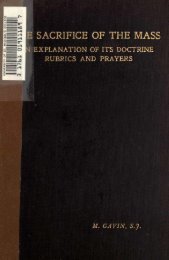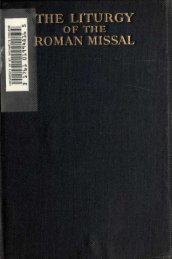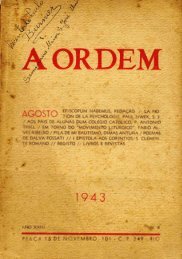E SACRIFICE OF THE MASS
E SACRIFICE OF THE MASS
E SACRIFICE OF THE MASS
You also want an ePaper? Increase the reach of your titles
YUMPU automatically turns print PDFs into web optimized ePapers that Google loves.
158<br />
<strong>THE</strong> CEREMONIES <strong>OF</strong> HIGH <strong>MASS</strong>.<br />
One word as to the candlesticks on the altar. We are<br />
told that the present custom of placing candlesticks on the<br />
altar dates from the ninth or tenth century ; previously<br />
to this period they were placed probably at the sides or<br />
before the altar.<br />
" In<br />
the private Masses of the ninth or<br />
tenth century, and in some places down to the end of<br />
the eighteenth century, the altar remained bare until the<br />
priest who was to say Mass actually arrived at the<br />
spot. The priest brought a little crucifix or cross along<br />
with the chalice, and the server carried a candlestick<br />
and candle. In all probability the six candlesticks we<br />
now see there, or seven when a Bishop pontificates, have<br />
sprung from the seven candles originally borne before<br />
the Roman Pontiff by the seven regionary acolytes."<br />
(Ceremonies of Holy Week, Good Friday, p. 6.)<br />
After this brief reference to the Church s use of<br />
candles at Mass we return to the consideration of<br />
the Ceremonies at High Mass. Instead of being crossed<br />
in front like the priest s, the deacon s stole stretches<br />
from the left shoulder across the breast and is fastened at<br />
his right side. Also, instead of the chasuble, the deacon<br />
and subdeacon wear special vestments called dalmatics.<br />
A dalmatic is a vestment open on each side, with wide<br />
sleeves, and marked with two stripes. It is worn by<br />
deacons at High Mass, at Processions and Benediction,<br />
and by Bishops under the chasuble when they celebrate<br />
Mass pontifically. The colour is the same as that of<br />
the celebrant s chasuble. The word is derived from<br />
Dalmatia. The dalmatic was a long undergarment of<br />
white Dalmatian wool corresponding to the Roman<br />
tunic. Originally it was a garment of everyday<br />
life.<br />
The use of the dalmatic as a vestment was first<br />
peculiar to the Popes, and then permitted by them






